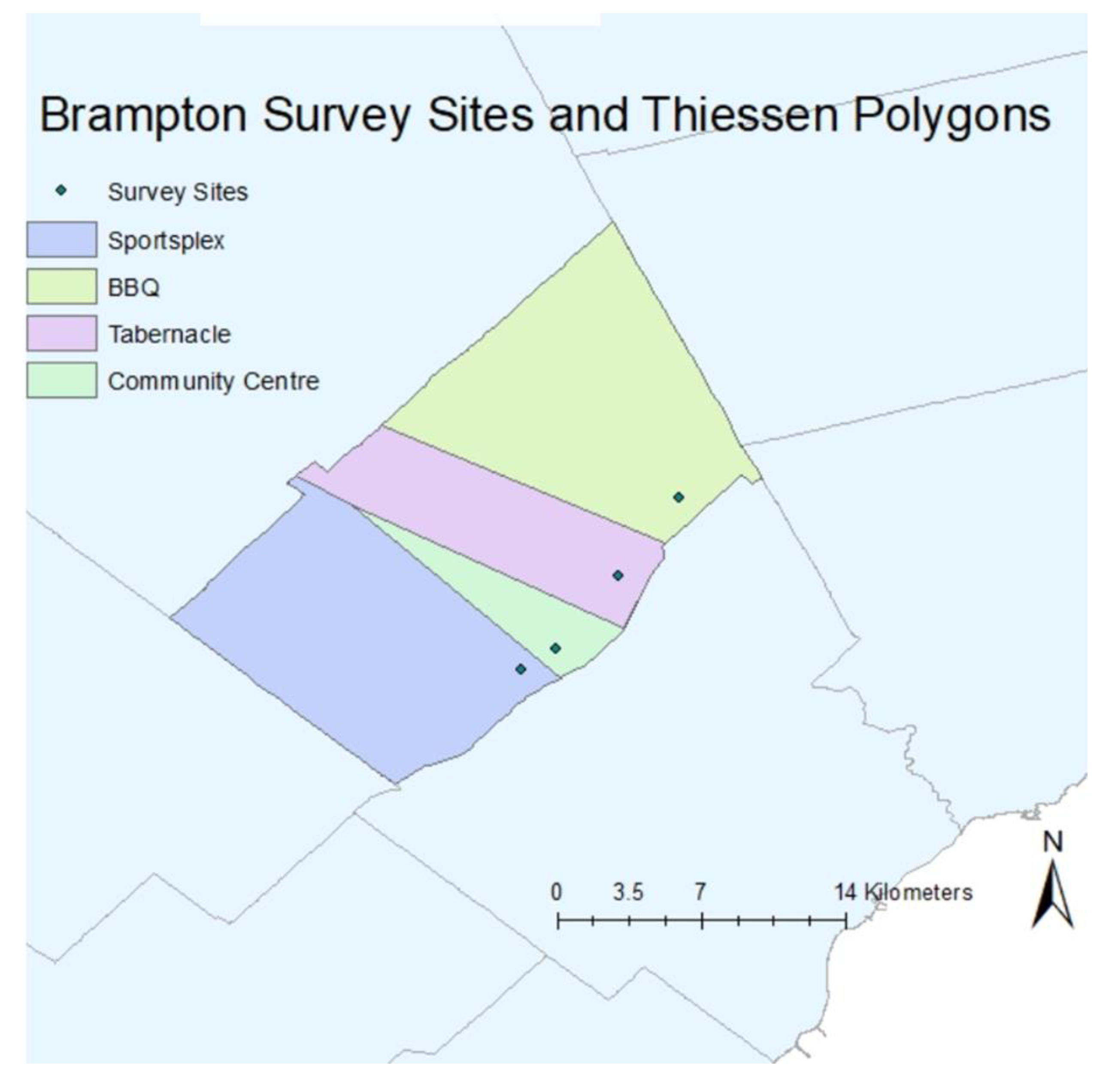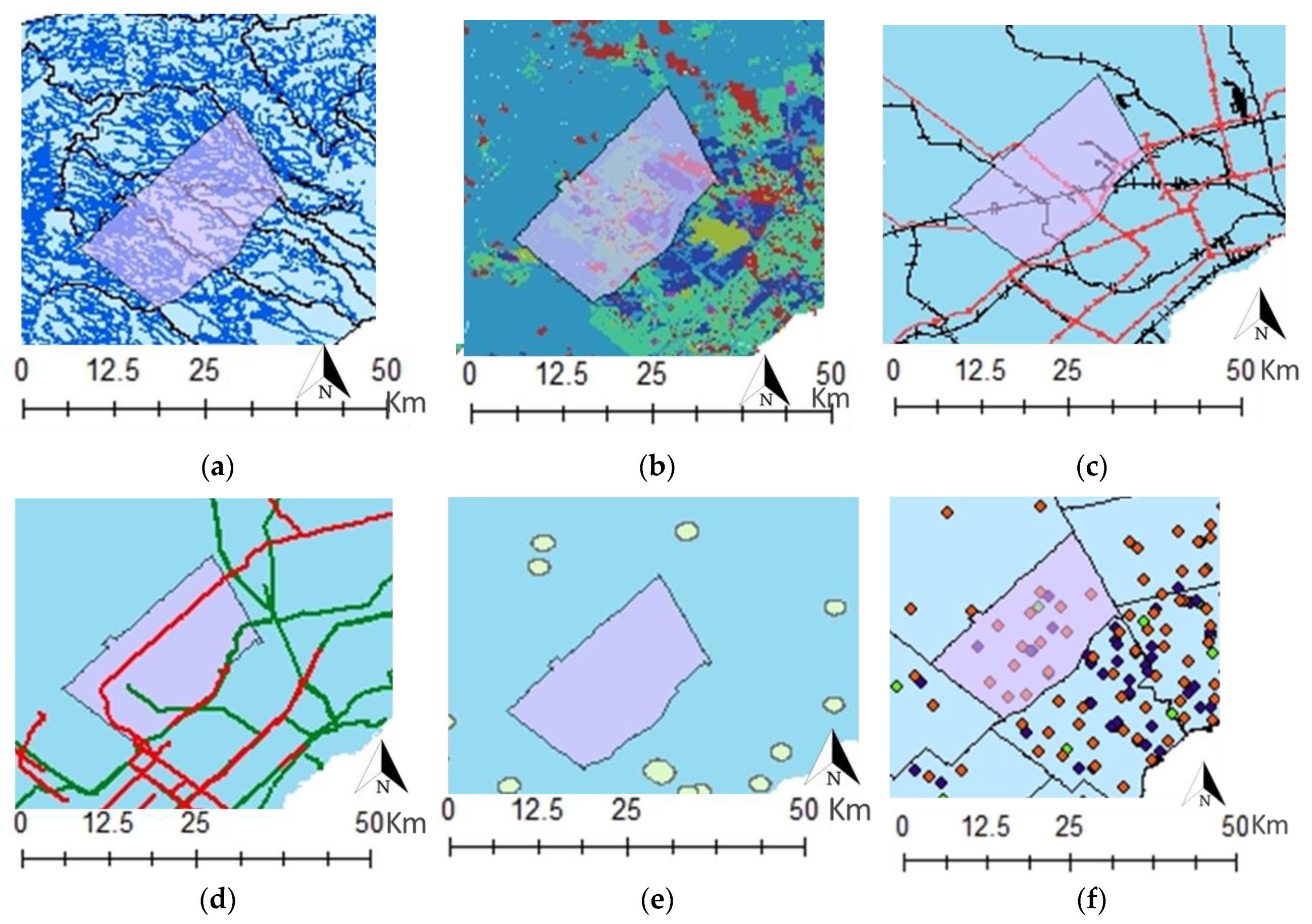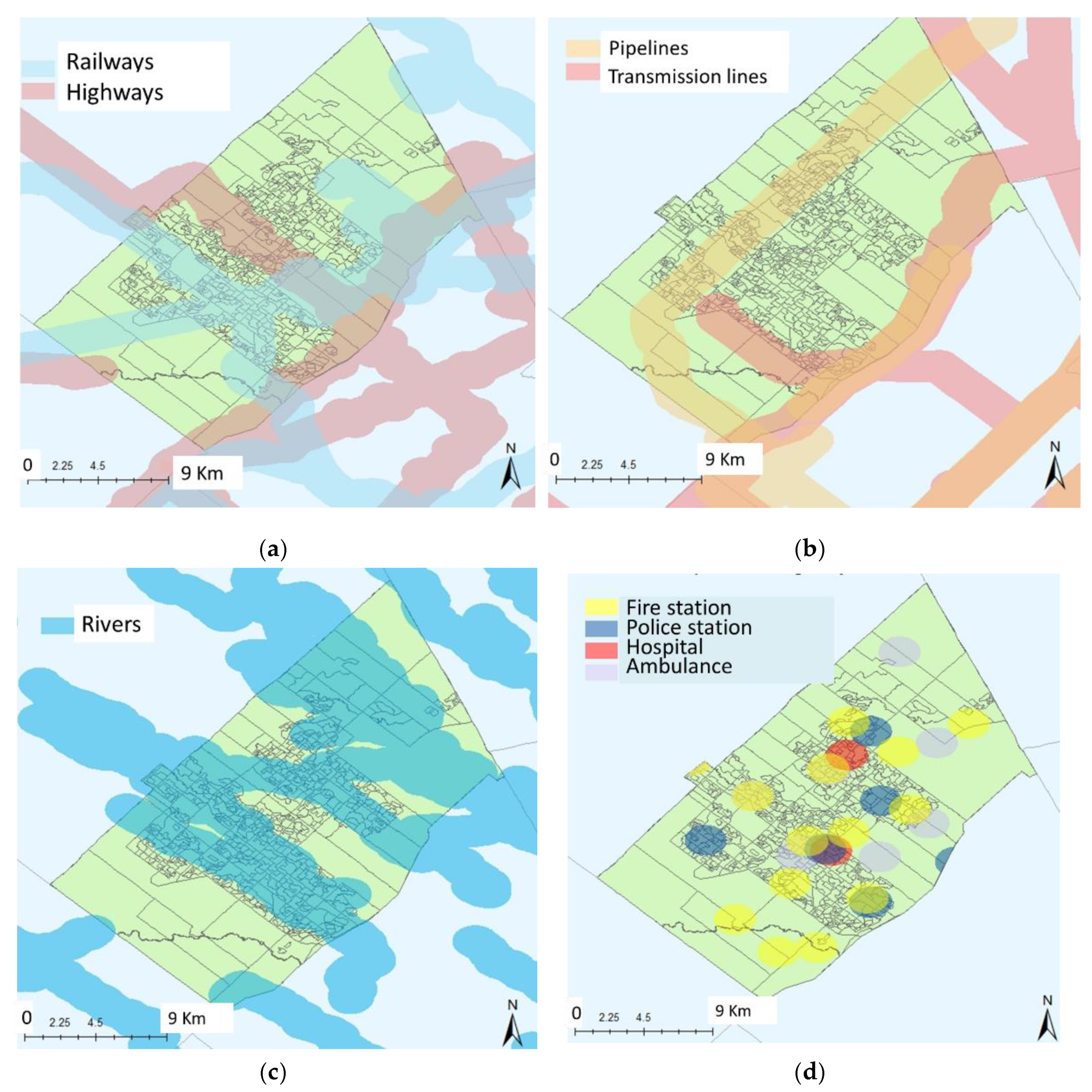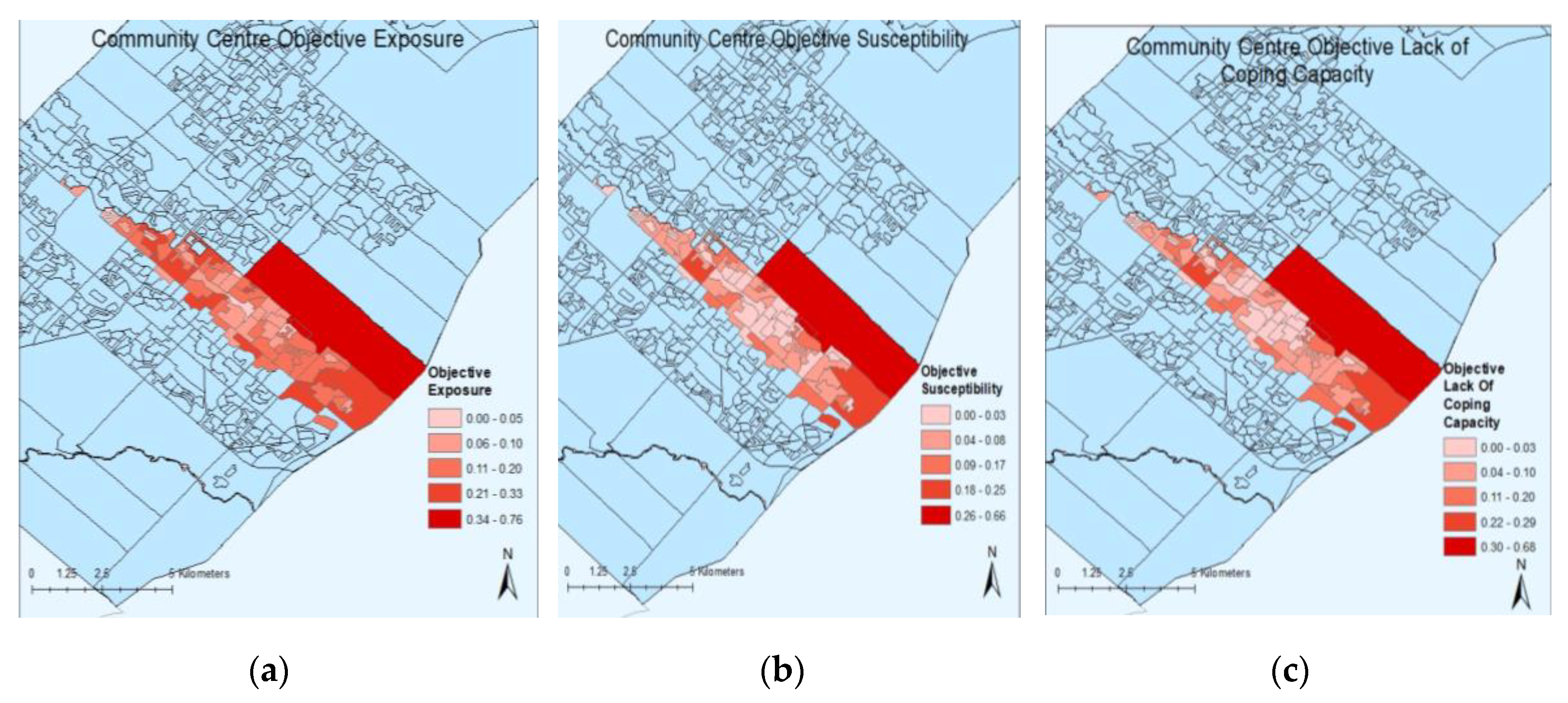Risk and Resilience: A Case of Perception versus Reality in Flood Management
Abstract
:1. Introduction
- Enhance whole-of-society collaboration and governance to strengthen resilience.
- Improve understanding of disaster risks in all sectors of society.
- Increase focus on whole-of-society disaster prevention and mitigation activities.
- Enhance disaster response capacity and coordination and foster the development of new capabilities.
- Strengthen recovery efforts by building back better to minimize the impacts of future disasters.
2. Materials and Methods
- River (flood risk)
- The transportation network (risk from derailment, explosion, oil spill)
- Chemical plants and hazardous industries
- Transmission lines (elevated health risk from high voltage corridors)
- Oil and gas pipelines (toxic spills)
- Garbage dumpsites (a potential failing of large piles, health, and environmental hazard)
- Ownership/renting status of the residence
- Crowdedness factor based on the number of members in the household
- Language ability—English or French
- Employment status
- Job satisfaction
- Age—assuming that the very young and the very old would be more susceptible to the exposure to the disaster risk
- Persons with disability
- Level of education
- Family income
- Means of transportation (personal or public)
- Social network support
- Disaster experience by family or friends
- Importance of disaster preparedness
- Engagement in local politics as a proxy of participation
3. Results
4. Discussion and Conclusions
Author Contributions
Funding
Acknowledgments
Conflicts of Interest
Appendix A. List of Data Sources
| Data | Source |
| Exposure | |
| Highways | DMTI Spatial, 2015 http://geo.scholarsportal.info/#r/details/_uri@=2347499980 |
| Rail Lines | Ontario Ministry of Natural Resources, 2012 |
| Industrial Sites | Canada, Federal Government Open Data Program, created by request, 2016 |
| GTA Pipes, Transmission Lines | DMTI Spatial, 2014 |
| Slope and DEM | DMTI Spatial, 2015 (retired) |
| Major Rivers | Provided by Toronto and Region Conservation Authority |
| Susceptibility | |
| Home Ownership | Statscan, 2011 census data via http://dc1.chass.utoronto.ca/census/ |
| Age of Construction | Statscan, 2011 census data via http://dc1.chass.utoronto.ca/census/ |
| Language Skills | Statscan, 2011 census data via http://dc1.chass.utoronto.ca/census/ |
| Employment | Statscan, 2011 census data via http://dc1.chass.utoronto.ca/census/ |
| Age | Statscan, 2011 census data via http://dc1.chass.utoronto.ca/census/ |
| Disability | Statistics Canada, by request, 2017 |
| Property Value | online real estate listings (ReMax), geocoded by address in ArcGIS Online |
| Coping Capacity | |
| GTA Fires Stations | http://geo.scholarsportal.info/#r/details/_uri@=3739967620 |
| GTA Police Stations | http://geo.scholarsportal.info/#r/details/_uri@=3739967620 |
| GTA Hospitals | http://geo.scholarsportal.info/#r/details/_uri@=3570906326 |
| Ambulance Stations | Addresses gathered from publicly available information at municipal websites, Wikipedia, and Google; geocoded using ArcGIS Online |
| Income | Statscan, 2011 census data via http://dc1.chass.utoronto.ca/census/ |
| Education | Statscan, 2011 census data via http://dc1.chass.utoronto.ca/census/ |
| Miscellaneous | |
| Watercourses | Ontario Ministry of Natural Resources, 2011 |
| Watersheds | Ontario Ministry of Natural Resources, 2011 |
| Dissemination Areas | University of Toronto Census Analyzer http://dc1.chass.utoronto.ca/census/ |
| Land Use | DMTI Spatial, 2014 http://geo.scholarsportal.info/#r/details/_uri@=2785150059$DMTI_2014_CanMapRL_Topo_LUR_ALL_PROV |
| Census Tracts | University of Toronto Census Analyzer http://dc1.chass.utoronto.ca/cgi-bin/census/2011nhs/displayCensus.cgi?year=2011&geo=ct |
| GTA Municipalities | DMTI Spatial, 2014 http://geo.scholarsportal.info/#r/details/_uri@=4044335176$DMTI_2014_CanMapRL_Streets_MUN_ALL_PROV |
| Education | DMTI Spatial, 2015 http://geo.scholarsportal.info/#r/details/_uri@=4062179246 |
References
- Pazzi, V.; Morelli, S.; Pratesi, F.; Sodi, T.; Valori, L. Assessing the safety of schools affected by geo-hydrologic hazards: The geohazard safety classification (GSC). Int. J. Disaster Risk Reduct. 2016, 15, 80–93. [Google Scholar] [CrossRef] [Green Version]
- Schiermeier, Q. Increased flood risk linked to global warming. Nature 2011, 470, 316. [Google Scholar] [CrossRef] [Green Version]
- Bempah, S.A.; Oyhus, A.O. The role of social perception in disaster risk reduction: Beliefs, perception, and attitudes regarding flood disasters in communities along the Volta River, Ghana. Int. J. Disaster Risk Reduct. 2017, 23, 104–108. [Google Scholar] [CrossRef]
- Ranjan, E.S.; Abenayake, C.C. A study on community’s perception on disaster resilience concept. Procedia Econom. Financ. 2014, 18, 88–94. [Google Scholar] [CrossRef] [Green Version]
- Cutter, S. Preface. In Disaster Resilience: A National Imperative, Committee on Increasing National Resilience to Hazards and Disasters; The National Academies Press: Washington, DC, USA, 2011; p. 244. [Google Scholar]
- Cutter, S.L.; Barnes, L.; Berry, M.; Burton, C.; Evans, E.; Tate, E. A place-based model for understanding community resilience to natural disasters. Glob. Environ. Chang. 2008, 18, 598–606. [Google Scholar] [CrossRef]
- Birkholz, S.; Muro, M.; Jeffrey, P.; Smith, H.M. Rethinking the relationship between flood risk perception and flood management. Sci. Total Environ. 2014, 478, 12–20. [Google Scholar] [CrossRef] [PubMed]
- Santoro, S.; Pluchinotta, I.; Pagano, A.; Pengal, P.; Cokan, B.; Giordano, R. Assessing stakeholders’ risk perception to promote Nature Based Solutions as flood protection strategies: The case of the Glinščica River (Slovenia). Sci. Total Environ. 2019, 655, 188–201. [Google Scholar] [CrossRef] [PubMed]
- Lei, Y.; Wang, J.; Yue, Y.; Zhou, H.; Yin, W. Rethinking the relationships of vulnerability, resilience, and adaptation from a disaster risk perspective. Nat. Hazards 2014, 70, 609–627. [Google Scholar] [CrossRef]
- Hyogo Framework for Action (HFA) 2005–2015 Building the Resilience of Nations and Communities to Disasters. Available online: www.unisdr.org (accessed on 4 April 2020).
- Sendai Framework for Disaster Risk Reduction (SF-DRR) 2015–2030; The United Nations Office for Disaster Risk Reduction: Geneva, Switzerland. Available online: www.unisdr.org (accessed on 4 April 2020).
- Cutter, S.L.; Boruff, B.J.; Shirley, W.L. Social vulnerability to environmental hazards. Soc. Sci. Q. 2003, 84, 242–261. [Google Scholar] [CrossRef]
- Few, R. Flooding, vulnerability and coping strategies: Local responses to a global threat. Prog. Dev. Stud. 2003, 3, 43–58. [Google Scholar] [CrossRef]
- Messner, F.; Meyer, V. Flood damage, vulnerability and risk perception—Challenges for flood damage research. In Flood Risk Management: Hazards, Vulnerability and Mitigation Measures; NATO Science Series; Schanze, J., Zeman, E., Marsalek, J., Eds.; Springer: Dordrecht, The Netherlands, 2006; Volume 67. [Google Scholar]
- Kuhlick, C.; Scolobig, A.; Tapsell, S.; Steinführer, A.; Marchi, B.D. Contextualizing Social Vulnerability: Findings from Case Studies across Europe; Springer Science & Business Media B.V.: New York, NY, USA, 2011. [Google Scholar]
- Burns, J.W.; Slovic, P. Risk perception and behaviors: Anticipating and responding to crises. Risk Anal. 2012, 32, 579–582. [Google Scholar] [CrossRef] [PubMed]
- Paton, D.; Johnston, D. Disaster Resilience: An Integrated Approach, 2nd ed.; Charles, C., Ed.; Thomas Publisher: Springfield, IL, USA, 2017; p. 438. [Google Scholar]
- Chang, S.E.; Shinozuka, M. Measuring improvements in the disaster resilience of communities. Earthq. Spectra 2004, 20, 739–755. [Google Scholar] [CrossRef]
- Welle, T.; Birkmann, J. The World Risk Index—An approach to assess risk and vulnerability on a global scale. J. Extreme Events 2015, 2, 1550003. [Google Scholar] [CrossRef]
- Folke, C.; Carpenter, S.R.; Walker, B.; Scheffer, M.; Chapin, T.; Rockström, J. Resilience thinking: Integrating resilience, adaptability and transformability. Ecol. Soc. 2010, 15, 20–29. [Google Scholar] [CrossRef]
- Folke, C. Resilience: The emergency of a perspective for social-ecological systems analyses. Glob. Environ. Chang. 2006, 16, 253–267. [Google Scholar] [CrossRef]
- Kuhlicke, C.; Steinführer, A. Preface: Building social capacities for natural hazards: An emerging field for research and practice in Europe. Nat. Hazards Earth Syst. Sci. 2015, 15, 2359–2367. [Google Scholar] [CrossRef]
- McEwen, L.J.; Krause, F.; Jones, O.; Garde-Hansen, J. Sustainable flood memories, informal knowledge and the development of community resilience to future flood risk. WIT Trans. Ecol. Environ. 2012, 159, 253–264. [Google Scholar]
- Ashley, R.M.; Blanskby, J.; Newman, R.; Gersonius, B.; Poole, A.; Lindley, G.; Smith, S.; Ogden, S.; Nowell, R. Learning and action alliances to build capacity for flood resilience. J. Flood Risk Manag. 2012, 5, 14–22. [Google Scholar] [CrossRef]
- Schelfaut, K.; Pannemans, B.; van der Craats, I.; Krywkow, J.; Mysiak, J.; Cools, J. Bringing flood resilience into practice: The FREEMAN project. Environ. Sci. Policy 2011, 14, 825–833. [Google Scholar] [CrossRef]
- Hung, H.C.; Yang, C.Y.; Chien, C.Y.; Liu, Y.C. Building resilience: Mainstream community participation into integrated assessment of resilience to climatic hazards in metropolitan land use management. Land Use Policy 2016, 50, 48–58. [Google Scholar] [CrossRef]
- WMO. Building Resilience through Community Participation—A Report on the Pilot Project on Community Flood Management in Bangladesh, India and Nepal; WMO: Geneva, Switzerland, 2017. [Google Scholar]
- UN-DRR. United Nations Office for Disaster Risk Reduction. Available online: https://www.undrr.org/terminology/capacity (accessed on 4 April 2020).
- Birkmann, J. (Ed.) Basic principles, and theoretical concepts. In Measuring Vulnerability to Natural Hazards: Towards Disaster Resilient Societies; United Nations University Press: Tokyo, Japan, 2006; p. 524. [Google Scholar]
- Birkmann, J.; Cardona, O.D.; Carreno, M.L.; Barbat, A.H.; Pelling, M.; Scheiderbauer, S.; Kienberger, S.; Keiler, M.; Alexandar, D.; Zeil, P.; et al. Framing vulnerability, risk and societal responses: The MOVE framework. Nat. Hazards 2003, 67, 193–211. [Google Scholar] [CrossRef]
- Boin, A.; Comfort, L.K.; Demchak, C.C. The rise of resilience. In Designing Resilience: Preparing for Extreme Events; Comfort, L.K., Boin, A., Demchak, C.C., Eds.; University of Pittsburgh Press: Pittsburgh, PA, USA, 2010. [Google Scholar]
- Britton, N.R.; Clark, G.J. From response to resilience: Emergency management reform in New Zealand. Nat. Hazards Rev. 2000, 1, 145–150. [Google Scholar] [CrossRef]
- Brooks, N. Vulnerability, risk, and adaptation: A conceptual framework. Tyndall Cent. Clim. Chang. Res. Work. Pap. 2003, 38, 1–16. [Google Scholar]
- Simonovic, S.P.; Peck, A. Dynamic resilience to climate change caused natural disasters in coastal megacities quantification framework. Br. J. Environ. Clim. Chang. 2013, 3, 378–401. [Google Scholar] [CrossRef]
- Timmerman, P. Vulnerability, resilience and the collapse of society: A review of models and possible climatic applications. In Environmental Monograph No. 1; Institute for Environmental Studies, University of Toronto: Toronto, ON, Canada, 1981. [Google Scholar]
- Turner, B.L. Vulnerability and resilience: Coalescing or paralleling approaches for sustainability science? Glob. Environ. Chang. 2010, 20, 570–576. [Google Scholar] [CrossRef]
- Government of Canada. Emergency Management Strategy for Canada: Toward a Resilient 2030; Public Safety Canada Report; Public Safety Canada: Ottawa, ON, Canada, 2019; ISBN 978-0-660-29248-9.
- EM-DAT. The International Disaster Database, Centre for Research on the Epidemiology of Disasters 2019. Available online: http://www.emdat.be/disaster_trends/index.html (accessed on 16 March 2020).
- Canadian Disaster Database. Public Safety Canada 2019. Available online: https://www.publicsafety.gc.ca/cnt/mrgnc-mngmnt/ntrl-hzrds/index-en.aspx (accessed on 16 March 2020).
- Nirupama, N.; Maula, A. Engaging public for building resilient communities to reduce disaster impact. Nat. Hazards 2013, 66, 51–59. [Google Scholar] [CrossRef]
- Nirupama, N.; Etkin, D. Institutional perception and support in emergency management in Ontario, Canada. Disaster Prev. Manag. 2012, 21, 599–607. [Google Scholar] [CrossRef]
- Nirupama, N.; Etkin, D. Emergency managers in Ontario: An exploratory study of their perspective. J. Homel. Secur. Emer. Manag. 2009, 6. [Google Scholar] [CrossRef]
- Nirupama, N. Risk, and vulnerability assessment—A comprehensive approach. Int. J. Disaster Resil. Built Environ. 2012, 3, 2. [Google Scholar] [CrossRef]
- Bruneau, M.; Chang, S.E.; Eguchi, R.T.; Lee, G.C.; O’Rourke, T.D.; Reinhorn, A.M.; Shinozuka, M.; Tierney, K.; Wallace, W.A.; von Winterfeldt, D. A framework to quantitatively assess and enhance the seismic resilience of communities. Earthq. Spectra 2003, 19, 733–752. [Google Scholar] [CrossRef] [Green Version]
- Building Resilient Communities. Fort McMurray Wildfire: Learning from Canada’s Costliest Disaster; Institute for Catastrophic Loss Reduction: Zurich, Switzerland, 2019. [Google Scholar]
- McGee, T.K. Public engagement in neighbourhood level wildfire mitigation and preparedness: Case studies from Canada, the US and Australia. J. Environ. Manag. 2011, 92, 2524–2532. [Google Scholar] [CrossRef]
- Koksal, K.; McLennan, J.; Bearman, C. Living with bushfires on the urban-bush interface. Aust. J Emerg. Manag. 2020, 35, 21–28. [Google Scholar]
- Miller, F.; Osbahr, H.; Boyd, E.; Thomalla, F.; Bharwani, S.; Ziervogel, G.; Walker, B.; Birkmann, J.; Vander Leeuw, S.; Rockstro¨m, J.; et al. Resilience and vulnerability: Complementary or conflicting concepts? Ecol. Soc. 2010, 15, 11. [Google Scholar] [CrossRef]
- Slovic, P. The Feeling of Risk: New Perspectives on Risk Perception; Routledge: London, UK, 2010; p. 425. [Google Scholar]
- Bandecchi, A.E.; Pazzi, V.; Morelli, S.; Valori, L.; Casagli, N. Geo-hydrological and seismic risk awareness at school: Emergency preparedness and risk perception evaluation. Int. J. Disaster Risk Reduct. 2019, 40, 101–280. [Google Scholar] [CrossRef]
- Arnstein, S.R. A ladder of citizen participation. J. Am. Inst. Plan. 1969, 35, 216–224. [Google Scholar] [CrossRef] [Green Version]
- Few, R.; Brown, K.; Tompkins, E. Public participation and climate change adaptation: Avoiding the illusion of inclusion. Clim. Policy 2007, 7, 46–59. [Google Scholar] [CrossRef]
- Cutter, S.L.; Burton, C.G.; Emrich, C.T. Disaster Resilience indicators for benchmarking baseline conditions. J. Homel. Secur. Emerg. Manag. 2010, 7, 51. [Google Scholar] [CrossRef]
- Armenakis, C.; Nirupama, N. Estimating spatial disaster risk in urban environments. Geomat. Nat. Hazards Risk 2013, 4, 289–298. [Google Scholar] [CrossRef] [Green Version]
- Irwin, S.; Simonovic, S.P.; Nirupama, N. Introduction to ResilSIM: A Decision Support Tool for Estimating Disaster Resilience to Hydro-Meteorological Events; Water Resources Research Report No. 094; Facility for Intelligent Decision Support, Department of Civil and Environmental Engineering, Western University: London, ON, Canada, 2016; p. 66. ISBN (print) 978-0-7714-3115-9; (online) 978-0-7714-3116-6. [Google Scholar]
- Kovacs, P.; Kunreuther, H. Managing Catastrophic Risk: Lessons from Canada 2001. Available online: http://www.iclr.org/images/Managing_Catastrophic_Risk.pdf (accessed on 4 April 2020).
- Smith, K. (Ed.) Environmental Hazards: Assessing Risk and Reducing Disaster, 2nd ed.; Routledge: London, UK, 1996. [Google Scholar]
- Holling, C.S. Resilience and stability of ecological systems. Annu. Rev. Ecol. Syst. 1973, 4, 1–23. [Google Scholar] [CrossRef] [Green Version]
- Kasperson, J.X.; Kasperson, R.E. The Social Contours of Risk; Earthscan: London, UK, 2005. [Google Scholar]
- Klein, R.J.T.; Nicholls, R.J.; Thomalla, F.T. Resilience to natural hazards: How useful is this concept? Environ. Hazards 2003, 5, 35–45. [Google Scholar] [CrossRef]
- McLaughlin, P. Climate change, adaptation, and vulnerability: Reconceptualizing societal-environment interaction within a socially constructed adaptive landscape. Organ. Environ. 2011, 24, 269–291. [Google Scholar] [CrossRef]
- Paton, G. Disaster resilience: Building capacity to co-exist with natural hazards and their consequences. In Disaster Resilience; Charles C. Thomas Publishers: Springfield, IL, USA, 2006; p. 321. [Google Scholar]
- Walker, B.; Holling, C.S.; Carpenter, S.R.; Kinzig, A. Resilience, adaptability and transformability in social-ecological systems. Ecol. Soc. 2004, 9, 5. [Google Scholar] [CrossRef]
- Wisner, B.; Blaikie, P.; Cannon, T.; Davis, I. At Risk: Natural Hazards, People’s Vulnerability, and Disasters, 2nd ed.; Routledge: London, UK, 2004; p. 471. [Google Scholar]
- Bazeley, P. Qualitative Data Analysis: Practical Strategies; Sage Publications: Thousand Oaks, CA, USA, 2013; p. 472. [Google Scholar]
- Creswell, J.W.; Shope, R.; Plano Clark, V.L.; Green, D.O. How interpretive qualitative research extends mixed methods research. Res. Sch. 2006, 13, 1–11. [Google Scholar]
- Ratner, C. Subjectivity and objectivity in qualitative methodology. Forum Qual. Soc. Res. 2002, 3, 16. [Google Scholar]
- Mamuji, A.; Rozdilsky, J.L. Canada’s 2016 Fort McMurray Wildfire Evacuation: Experiences of the Muslim Community. Int. J. Emerg. Manag. 2019, 15, 125–146. [Google Scholar] [CrossRef]
- Siegrist, M.; Gutscher, H. Natural hazards and motivation for mitigation behavior: People cannot predict the affect evoked by a severe flood. Risk Anal. 2008, 28, 771–778. [Google Scholar] [CrossRef]
- Simonovic, S.; Nirupama, N. A spatial multi-objective decision making under uncertainty for water resources management. J. Hydroinf. 2005, 7, 117–133. [Google Scholar] [CrossRef]
- Minguez, C.; Fermina, G.; Perez, R., II. Doctorate in Geography Workshop. In Proceedings of the XXV Congress of the Association of Spanish Geographers, Madrid, Spain, 25–27 October 2017. [Google Scholar]
- Malik, S.; Awan, H.; Khan, N. Mapping vulnerability to climate change and its repercussions on human health in Pakistan. Glob. Health 2012, 8, 31–41. [Google Scholar] [CrossRef] [Green Version]
- Twigg, J. Characteristics of a Disaster-Resilient Community: A Guidance Note; DFID Disaster Risk Reduction Interagency Coordination Group, Hazard Research Centre, Benfield UCL: London, UK, 2007; p. 39. [Google Scholar]
- Wallace, T.; Watkins, D.; Park, H.; Singhve, A.; Williams, J. How One Houston Suburb Ended up in a Reservoir; New York Times: New York, NY, USA, 2018. [Google Scholar]









| Parameter | Guidance for Assigning Binary Values 0 or 1 Based on Response to the Survey | |||
|---|---|---|---|---|
| Exposure Weight W1 | Question | Binary value = 0 | Binary value = 1 | Remarks |
| I live near a hazardous situation such as a river, chemical plant, etc. | If false | If true | Add all binary numbers to get total exposure | |
| Susceptibility Weight W2 | Question/variable | Binary value = 0 if response is as below | Binary value = 1 if response is as below | Remarks |
| My home is | Owned | Rented or other | Add all binary numbers to get total susceptibility | |
| # members in household (crowdedness) | <4 | >4 | ||
| Language (English) | very well/good | moderate/poor/blank | ||
| Employment | Full time/self-employed | Part time/retired | ||
| Job satisfaction | Very satisfied/satisfied | Somewhat satisfied/not satisfied/blank | ||
| Age | >20 and <65 | <20 and >65 | ||
| Disability | No | Yes | ||
| Lack of Coping Capacity Weight W3 | Question/variable | Binary value = 0 if response is as below | Binary value = 1 if response is as below | Remarks |
| Education | College and higher | Less than college | Add all binary values to get total lack of coping capacity | |
| Income | >50 K | <50 K | ||
| Transportation | Personal vehicle | Public/rideshare | ||
| Social network | Very important | Important/somewhat/other | ||
| Disaster experience | Yes | No/blank | ||
| Disaster preparedness option | Family/friend | Public shelter/blank | ||
| Voted in the past election | Yes | No/blank/n/a | ||
| Parameter | Criteria to Assign Binary Values to Variables | |||
|---|---|---|---|---|
| Exposure Weight W1 | Variable | Binary value = 0 | Binary value = 0 | Remarks |
| Highways, Railway tracks, River and creeks, Industries, Oil and gas pipelines, Dumpsites–stockpiles, Low lying areas (terrain/slope) | If no exposure to a potential hazard | If within 1 km buffer zone of any of the potentially hazardous situations | Add all binary assigned values to get total exposure | |
| Susceptibility Weight W2 | Variable | Binary value = 0 | Binary value = 1 | Remarks |
| Residence type | Detached/semi | Rented apartment | Add all binary assigned values to get total susceptibility | |
| Age of property construction | Post-1980 | Pre 1980 | ||
| Language | very well/good | moderate/poor/blank | ||
| Employment | Full time/self-employed | Part time/retired | ||
| Age | >20 and <65 | < 20 and >65 | ||
| Disability | No | Yes | ||
| Property value | >400 K | ≤400 K | ||
| Lack of Coping Capacity Weight W3 | Variable | Assign value = 0 | Assign value = 1 | Remarks |
| Education | College and higher | Less than college | Add all binary assigned values to get total lack of coping capacity | |
| Income | >50 K | ≤50 K | ||
| Disaster preparedness: Hospital | ≤1 km | >1 km away | ||
| Disaster preparedness: ambulance service | ≤1 km | >1 km away | ||
| Disaster preparedness: Health emergency services | ≤1 km | >1 km away | ||
| Disaster preparedness: Police station | ≤1 km | >1 km away | ||
© 2020 by the authors. Licensee MDPI, Basel, Switzerland. This article is an open access article distributed under the terms and conditions of the Creative Commons Attribution (CC BY) license (http://creativecommons.org/licenses/by/4.0/).
Share and Cite
Agrawal, N.; Elliott, M.; Simonovic, S.P. Risk and Resilience: A Case of Perception versus Reality in Flood Management. Water 2020, 12, 1254. https://doi.org/10.3390/w12051254
Agrawal N, Elliott M, Simonovic SP. Risk and Resilience: A Case of Perception versus Reality in Flood Management. Water. 2020; 12(5):1254. https://doi.org/10.3390/w12051254
Chicago/Turabian StyleAgrawal, Nirupama, Mark Elliott, and Slobodan P Simonovic. 2020. "Risk and Resilience: A Case of Perception versus Reality in Flood Management" Water 12, no. 5: 1254. https://doi.org/10.3390/w12051254
APA StyleAgrawal, N., Elliott, M., & Simonovic, S. P. (2020). Risk and Resilience: A Case of Perception versus Reality in Flood Management. Water, 12(5), 1254. https://doi.org/10.3390/w12051254







